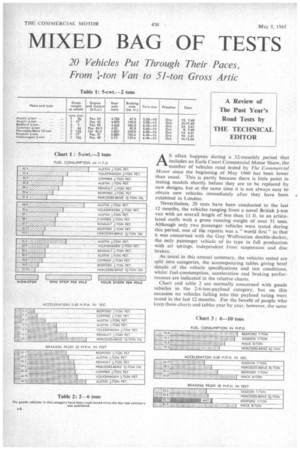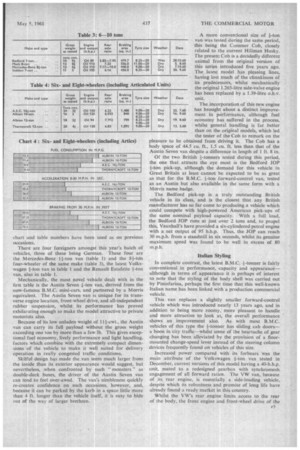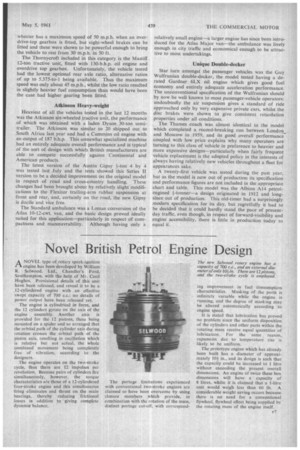MIXED BAG OF TESTS
Page 92

Page 93

Page 94

Page 95

If you've noticed an error in this article please click here to report it so we can fix it.
AS often happens during a I2-monthly period that includes an Earls Court Commercial Motor Show, the number of vehicles road tested by The Commercial Motor since the beginning of May 1960 has been lower than usual. This is partly because there is little point in testing models shortly before they are to be replaced by new designs. but at the same time it is not always easy to obtain new vehicles immediately after they have been A
exhibited in London. .
Nevertheless, 20 tests have been conducted in the last 12 months, the vehicles ranging from a novel British +-ton van with an overall length of less than 11 ft. to an articulated outfit with a gross running weight of over 51 tons. Although only two passenger vehicles were tested during this period, one of the reports was a "world first" in that it was concerned with the Guy Wulfrunian double-decker, the only passenger vehicle of its type in full production with air springs, independent front suspension and disc brakes.
As usual in this annual summary, the vehicles tested are split into categories, the accompanying tables giving brief details of the vehicle specifications and test conditions, whilst fuel-consumption, acceleration and braking performances are indicated in the relative charts.
Chart and table 2 are normally concerned with goods vehicles in the 2-6-ton-payload category, but on this occasion no vehicles falling into this payload rating were tested in the last 12 months. For the benefit of people who keep these charts and tables year by year, however, the same chart and table numbers have been used as on previous occasions.
There are four foreigners amongst this year's batch of vehicles, three of these being German. These four are the Mercedes-Benz 1+-ton van (table 1) and the 81-ton four-wheeler of the same make (table 3), the latest Volkswagen +-ton van in table 1 and the Renault Estafette van, also in table 1.
Mechanically, the most novel vehicle dealt with in the first table is the Austin Seven 1-ton van, derived from the now-famous RM.C. mini-cars, and partnered by a Morris equivalent. The Austin Seven van is unique for its transverse engine location, front-wheel drive, and all-independent rubber suspension, whilst its performance has proved exhilarating enough to make the model attractive to private motorists also.
Because of its low unladen weight of 111-cwt., the Austin van can carry its full payload without the gross weight exceeding one ton by more than a few lb. This gives exceptional fuel economy, lively performance and light handling, factors which combine with the extremely compact dimensions of the vehicle to make it well suited for delivery operation in really congested traffic conditions.
Skilful design has made the van seem much larger from the inside than its exterior appearance would suggest, but nevertheless, when confronted by such " monsters " as double-deck buses, the driver of the Austin Seven van can tend to feel over-awed. The van's nimbleness quickly re-creates confidence on such occasions, however, and, because it can be parked by the kerb in a space little more than 4 ft. longer than the vehicle itself, it is easy to hide out of the way of larger brethren, A more conventional size of T-ton van was tested during the same period, this being the Commer Cob, closely related to the current Hillman Husky. The present Cob is a decidedly different animal from the original version of this series introduced five years ago. The latest model has pleasing lines, having lost much of the chunkiness of its predecessors, whilst mechanically the original 1.265-litre side-valve engine has been replaced by a 1.39-litre o.h.v. unit.
The incorporation of this new engine has brought about a distinct improvement in performance, although fuel economy has suffered in the process, whilst general handling is far better than on the original models, which led the tester of the Cob to remark on the pleasure to be obtained from driving it. The Cob has a body space of 44.5 cu. ft., 1.5 cu. ft. less than that of the Austin Seven van despite a difference in length of 1 ft. 8 in.
Of the two British 1-tonners tested during this period, the one that attracts the eye most is the Bedford JO? 1-ton pick-up, although the demand for this vehicle in Great Britain at least cannot be expected to be as great as that for the B.M.C. 1-ton forward-control van, tested as an Austin but also available in the same form with a Morris name badge.
The Bedford pick-up is a truly outstanding British vehicle in its class, and is the closest that any British manufacturer has so far come to producing a vehicle which could compete with high-powered American pick-ups of the same nominal payload capacity. With a full load, the Bedford JOP runs at just over 2 tons and, to propel this, Vauxhall's have provided a six-cylindered petrol engine with a net output of 95 b.h.p. Thus, the JOP can reach 30 m.p.h. from a standstill in six seconds, whilst its genuine maximum speed was found to be well in excess of 80 m.p.h.
Dry 22. 7.60 Dry 16. 9.60 Dry 19. 840 Dry 13. 5.60
Italian Styling In complete contrast, the latest B.M.C. 1-tonner is fairly conventional in performance, capacity and appearance— although in terms of appearance it is perhaps of interest to note that the styling of the body shell was carried out by Pininfarina, perhaps the first time that this well-known Italian name has been linked with a production commercial vehicle.
This van replaces a slightly smaller forward-control vehicle which was introduced nearly 13 years ago, and in addition to being more roomy, more pleasant to handle and more attractive to look at, the overall performance shows an improvement also. As with most B.M.C. vehicles of this type the 1-tormer has sliding cab doors— a boon in city traffic—whilst some of the heartache of gear changing has been alleviated by the provision of a floormounted change-speed lever instead of the steering column devices frequently found on vehicles of this size.
Increased power compared with its forbears was the main attribute of the Volkswagen +-ton van tested in December, current versions of this model having a 40-b.h.p. unit, mated to a redesigned gearbox with synchromesh engagement of all forward ratios. The VW van, because of its rear engine, is essentially a side-loading vehicle, despite which its robustness and promise of long life have already found a ready market in this country.
Whilst the VW's rear engine limits access to the rear of the body, the front engine and front-wheel drive of the F5 Renault Estafette has exactly the opposite effect, the absence of a rear axle permitting a floor loading height of 141 in., which is constant from front to rear of the payload compartment when in the laden condition.
Mechanically, the Estafette has much in common with the Dauphine private car, and whilst the engine power output of 31 b.h.p. may seem small for a 10/12-cwt. vehicle, test figures showed the performance of the Estafette to be generally quite good, whilst handling reached a particularly high standard, partly because of the low centre of gravity.
Low power-to-weight ratio is a feature of the MercedesBenz 11-ton oil-engined van also, and this was reflected by somewhat sluggish acceleration figures, particularly in direct drive. Creditable features of this vehicle, however, were the cab access, driver comfort and general high standard of finish.
Outstanding of the four vehicles dealt with in section 3 is the Bedford TK 7-tonner, the first British commercialvehicle design really to give due prominence to the question of driver comfort. In respect of performance the Bedford TK models do not differ greatly from their forward-control predecessors, but by placing the engine beneath the cab seats, occupants of the cab do not have to struggle to reach or leave their seats, and once in the cab are relieved of the strain of excessive engine noise, besides being able to enjoy a grandstand view of the road ahead.
The relatively unorthodox engine position has not necessitated the use of horizontal or inclined power units, and hinged side panels behind the cab doors give surprisingly good access to the engine—far better than is given with many more-conventional forward-control layouts.
Another significant road test of a British vehicle falling into this category is that of the Seddon 7-tonner, the test report on which revealed first performance figures of F. Perkins' first six-cylindered direct-injection oil engine—the Six 354. This unit marks a complete departure from previous Perkins practice in all respects, whilst from the performance angle it was shown to be quiet, lively and
economical. Furthermore, its additional power output, compared with previous Perkins engines of equivalent size, leads to transmission simplification.
Weather Date
Dry 30.12.60 Dry 29. 7.60 Dry 10. 6.60
The Mack 8-tonner dealt with in this class was a British-built vehicle, despite what its name might suggest. The Mack tested was a normal-control machine—a rare layout for a British vehicle of this rating—and power output was supplied by a Leyland 110b.h.p. oil engine. The chassis showed all the signs of being particularly robust, and therefore suited for its intended duties overseas, whilst the spacious cab provided comfortable accommodation for a driver and two passengers.
Good cab design was a feature of the fourth vehicle in this category—the Mercedes-Benz LP327/44 13-ton-gross four-wheeler. The cab appointments in this vehicle reached a far higher standard than can bt found in the majority of production "heavies," whilst the road performance and general handling reached a high standard also. Although subject to import duty in Great Britain, the standard specification of this vehicle includes many items which are classed as extras on equivalent British models, therefore the Mercedes-Benz's overall effective price is by no means prohibitively high.
Two Albions
Two Albion models figure in category 4: these are the Chieftain 12-ton tractive unit and the Reiver 10-ton rigid sixwheeler. The Chieftain was tested at over 18 tons gross weight, resulting in a low power-to-weight ratio which carried the attendant advantage of good fuel economy without detracting too much from acceleration and gradient performances.
The Reiver tested was the newest of this range, incorporating the then new Leyland 0.400 125-b.h.p. oil engine and non-reactive bogie suspension, the layout of which materially helped to reduce rear-wheel hop when braking, particularly when unladen. Tested at over 16 tons gross weight, the new Leyland engine gave the Reiver a lively performance, with much less need than normal for troublesome use of the indirect gear ratios.
The outstanding performer in this category was the latest A.E.C. Mammoth Major Mk. V eight-wheeler, the road performance for which was quite outstanding for a vehicle capable of carrying a 161-ton payload. This eight wheeler has a maximum speed of 50 m.p.h. when an overdrive-top gearbox is fitted, but eight-wheel brakes can be fitted and these were shown to be powerful enough to bring the vehicle to rest from 30 m.p.h. in 50 ft.
The Thornycroft included in this category is the Mastiff 12-ton tractive unit, fitted with 130-b.h.p. oil engine and overdrive top gearbox. Unfortunately, the vehicle tested had the lowest optional rear axle ratio, alternative ratios of up to 5.375-to-1 being available. Thus the maximum speed was only about 45 m.p.h., whilst the low ratio resulted in slightly heavier fuel consumption than would have been the case had higher gearing been fitted.
Atkinson Heavy-weight
Heaviest of all the vehicles tested in the last 12 months was the Atkinson six-wheeled tractive unit, the performance of which was obtained with a laden Dyson 30-ton semitrailer. The Atkinson was similar to 20 shipped out to South Africa last year and had a Cummins oil engine with an output of 187 b.h.p. This somewhat specialized machine had an entirely adequate overall performance and is typical of the sort of design with which British manufacturers are able to compete successfully against Continental and American products.
The latest version of the Austin Gipsy ic-ton 4 by 4 was tested last July and the tests showed this Series II version to be a decided improvement on the original model in respect of road and cross-country handling,changes had been brought about by relatively slight modifications to the Flexitor trailing-arm rubber suspension at front and rear, and, certainly On the road, the new Gipsy is docile and vice free.
The Standard ambulance was a Lomas conversion of the Atlas 10-12-cwt. van, and the basic design proved ideally suited for this application—particularly in respect of compactness and manceuvrability. Although having only a relatively small engine—a larger engine has since been introduced for the Atlas Major van—the ambulance was lively enough in city traffic and economical enough to be attractive to most undertakings.
Unique Double-decker
Star turn amongst the passenger vehicles was the Guy Wulfrunian double-decker, the model tested having a derated Gardner 6LX oil engine which gives good fuel economy and entirely adequate acceleration performance. The unconventional specification of the Wulfrunian should by now be well known to most passenger-vehicle operators: undoubtedly the air suspension gives a standard of ride approached only by very expensive private cars, whilst the disc brakes were shown to give consistent retardation properties under all conditions.
The Thames coach was almost identical to the model which completed a record-breaking run between London_ and Moscow in 1959, and its good overall performance coupled with low price explains why many operators are turning to this class of vehicle in preference to heavier and more expensive designs—particularly when fairly frequent vehicle replacement is the adopted policy in the interests of always having relatively new vehicles throughout a fleet for appearances sake.
A twenty-first vehicle was tested during the past year, but as the model is now out of production its specification and performance figures are not included in the appropriate chart and table. This model was the Albion A 14 petrolengined -1-tonner—a design originated in 1912 and longsince out of production. This old-timer had a surprisingly modern specification for its day, but regretfully it had to be decided that it could hardly stand the pace of presentday traffic, even though, in respect of forward-visibility and engine accessibility, there is little in production today to equal it.








































































































































































































































































